Open and Accurate Air Quality Monitors
We design professional, accurate and long-lasting air quality monitors that are open-source and open-hardware so that you have full control on how you want to use the monitor.
Learn Moreby Anika Krause & Ethan Brooke on December 10, 2024
VOCs (volatile organic compounds) are a large group of organic chemicals that easily evaporate into the air at room temperature. They have a wide range of natural and synthetic sources and can significantly impact indoor and outdoor air quality. Because some VOCs can adversely affect human health and the environment, they are often discussed in the context of air pollution and health.
There are thousands of VOCs, both natural and synthetic. While no definitive number exists due to their diversity and the continuous discovery of new compounds, many are harmful (and many are not!). Currently, the EPA lists 189 pollutants as hazardous under the Clean Air Act, and many of these are VOCs. Some of the more infamous VOCs are formaldehyde, benzene, and toluene, but relatively harmless VOCs like ethanol also exist.
Since VOCs are very common indoors, many people seek air quality monitors that monitor these compounds. However, because there are so many different types of VOCs, sensing them is challenging, and it’s even more challenging to let users know if the VOCs present in their vicinity are harmful or not.
Today, we will examine how consumer-grade TVOC sensors work and discuss whether they are useful. We will also answer the question, ‘Is the AirGradient TVOC sensor any good?’
To first discuss if low-cost TVOC sensors are useful, we first need to clarify a few key points. Firstly, while there are many different air quality monitor companies - such as AirGradient - the companies that manufacture sensors for these monitors are far fewer. Currently, Sensirion and Bosch produce the vast majority of TVOC sensors used in a range of brands, from AirGradient to AirThings to PurpleAir. This is important to note because while this article is framed in the context of AirGradient monitors, it applies to most consumer-grade air quality monitors.
Secondly, both Sensirion and Bosch have moved away from showing absolute TVOC concentrations with their recent sensors. Instead, they’ve both made the decision to show relative indexes, which represent increasing or decreasing VOC levels in place of absolute values (such as concentration in parts per billion). But why is this?
It’s due to the fact that VOCs are simply too hard to accurately measure with low-cost components. Here are a few reasons why:
Lack of Specificity: Low-cost VOC sensors cannot distinguish between different types of VOCs, lumping all compounds into a single measurement. While seeing a VOC count of 1000ppb might be concerning, there’s no way to tell what the composition of VOCs is and, therefore, if they’re harmful or not.
Cross-sensitivity: VOC sensors need to be calibrated on a reference gas (typically ethanol) and are designed to read that gas accurately. However, their response to other VOCs varies depending on the chemical properties of the compounds present, so they aren’t consistently sensitive to different VOCs.
Environmental Sensitivity: Performance can be affected by changes in temperature and humidity. However, we will discuss this in more detail soon!
Baseline Drift: The baseline measurement can shift over time, reducing reliability without recalibration. Unfortunately, these low-cost sensors can’t be recalibrated without reference gasses, meaning that even absolute readings have limited usefulness as the sensor ages.
For these reasons, the ‘absolute’ values shown by low-cost VOC sensors are not reliable and should not be trusted. Due to the inherent difficulty of measuring VOCs, most sensor manufacturers have moved to indexes, which, while limited in showing absolute values, can indicate recent VOC trends.
Our science team, led by Dr. Anika Krause, wanted to investigate the exact utility of the VOC sensor (Sensirion SGP41) in our AirGradient monitors. To do this, they examined the sensor’s raw signals - the sensor’s primary output. The goal is to analyze the performance of these raw measurements and assess whether more valuable information, such as absolute values, could potentially be extracted.
Let’s first take a closer look at precision and how the SGP41 sensors in AirGradient monitors perform compared to each other as a sensor’s precision is a critical factor in determining its reliability.
Precision can be assessed by comparing multiple sensors of the same type under identical conditions. This comparison allows us to evaluate how consistently the sensors respond, offering insights into their reproducibility. By examining data from two TVOC sensors, we can observe their performance over time.

For more info about how to measure a sensor’s precision, see our webinar, from min 18:00.
In a time-series analysis of sensor outputs, it becomes clear that the readings from the two sensors align closely. When plotted over time, their respective output curves overlap significantly, suggesting that the sensors produce highly consistent measurements. This visual agreement provides the first indication of strong precision.
To quantify this relationship, we turn to the adjusted R-squared value, a statistical measure of correlation. For the sensors in question, the adjusted R-squared value is 0.85, which indicates a high level of agreement. An adjusted R-squared value closer to 1 represents a near-perfect correlation, while a value of 0 would suggest no correlation at all. This result supports the claim that the raw signals of the sensors are consistent and reproducible.
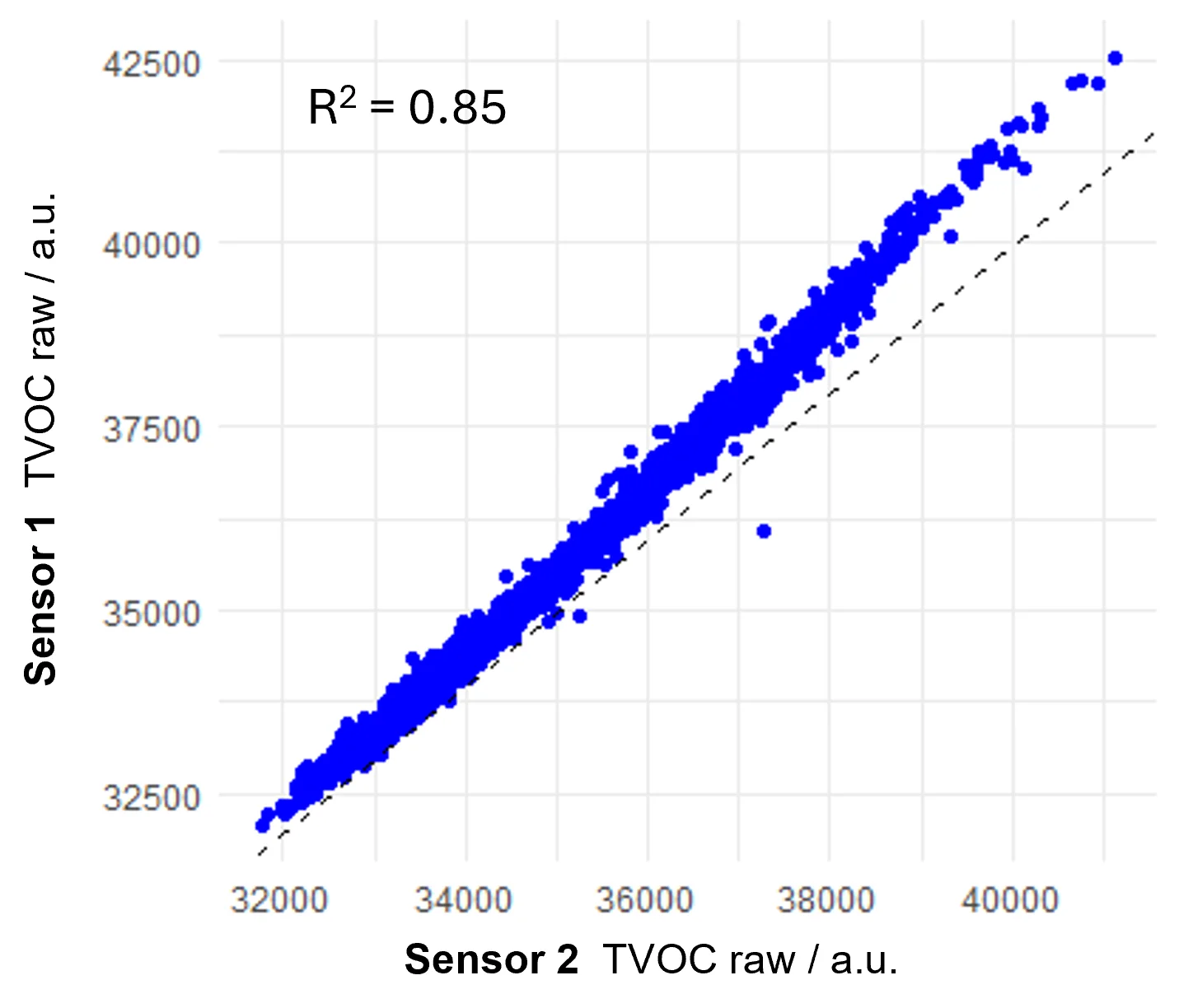
A scatterplot analysis further confirms the sensors’ precision. This analysis allows us to visualize the relationship between the two sensors’ outputs. Ideally, if the sensors were perfectly aligned in their measurements, all points on the scatterplot would fall directly on the line y=x, indicating exact agreement between the two devices.
In practice, the scatterplot reveals a near-linear distribution of data points, forming a close approximation to the ideal y=x line. From this analysis, it is evident that the raw signals from the TVOC sensors are highly consistent with one another, showcasing excellent reproducibility. High reproducibility is a key indicator of precision, meaning that the sensors can reliably measure changes in VOC levels without significant variability between individual devices of the same model.
This precision also implies that if the accuracy of one sensor is validated through testing, it can be reasonably assumed that other sensors of the same model will perform with similar accuracy.
To assess the accuracy of a TVOC sensor, we compared its raw signal to measurements from a reference instrument. The data presented here were collected at the Empa in Dübendorf, using their VOC reference instrument, a photoionization detector (PID). This type of detector is widely recognized for its ability to reliably measure VOC concentrations learn more.
The raw signal from the Sensirion TVOC sensor is measured in arbitrary units (a.u.) and behaves inversely to TVOC concentrations - higher TVOC levels cause the sensor’s raw signal to decrease. To facilitate comparison between the sensor and the reference instrument, we inverted the raw signal (1/TVOC_raw) and calibrated this signal using the following equation:
TVOC_cal = 1/TVOC_raw * scaling factor + intercept
Where scaling factor and intercept are derived from a linear regression between ref and 1/TVOC_raw.
As a next step, we want to compare the sensor signal with that of a reference instrument. In the following, we show data that was collected at the Empa in Duebendorf.
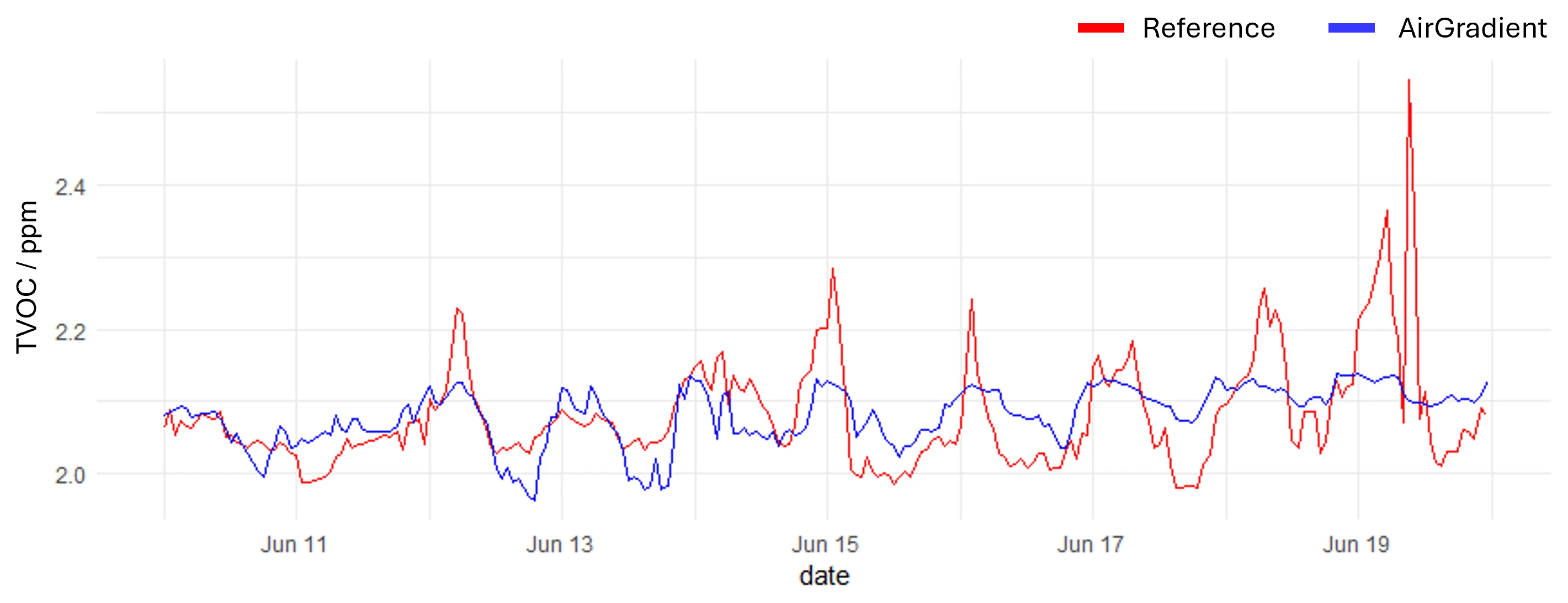
The time plot of the data reveals that while the sensor’s signal qualitatively tracks changes in the total VOC concentration -rising and falling in tandem with the reference - the amplitude of these changes does not match. This leads to a lower agreement between the sensor signal and reference instrument, which is reflected in a lower R squared value (0.27) and can also be seen in the not-so-linear shape of the dots in the scatter plot:
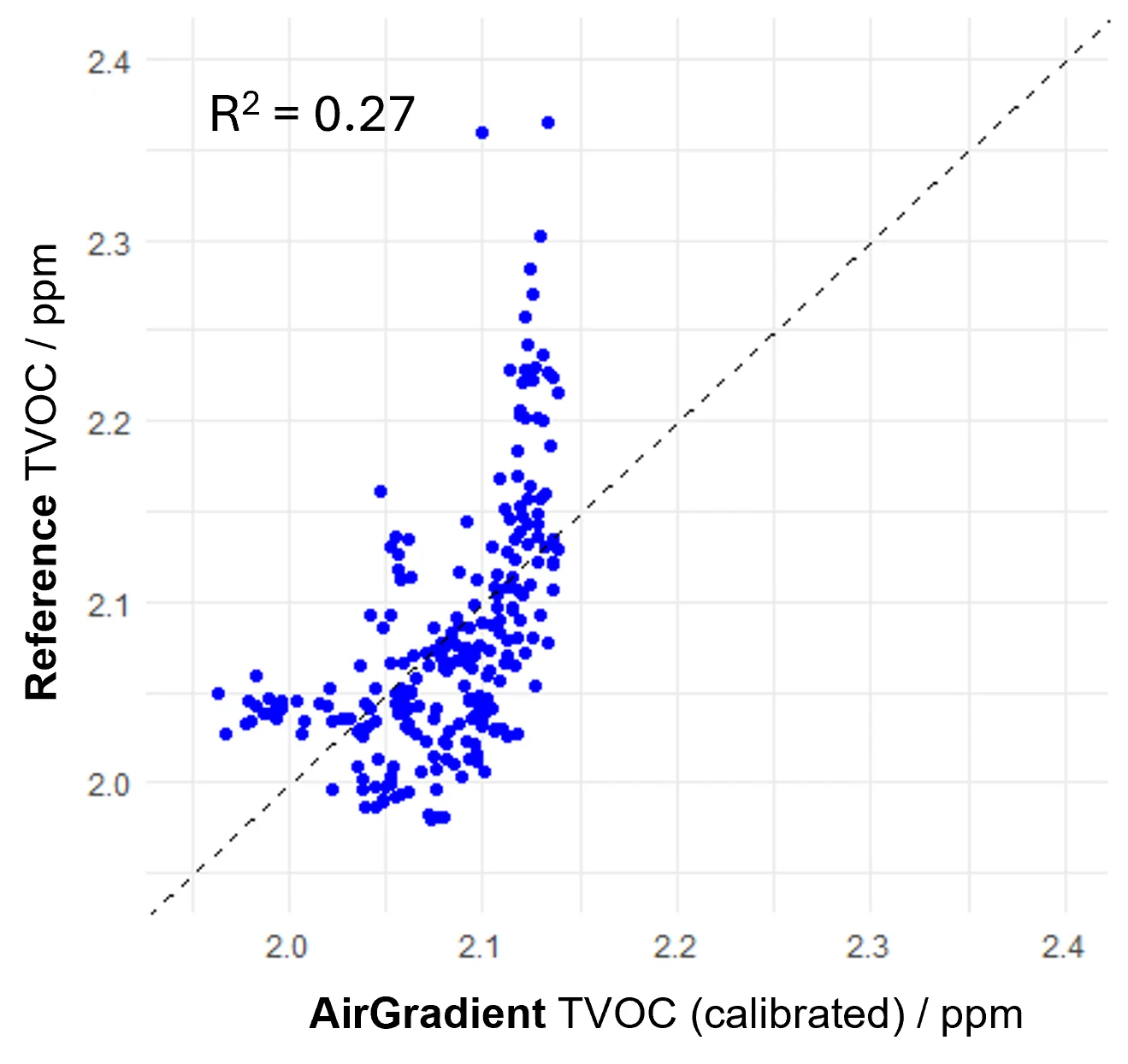
This discrepancy is likely due to the sensor’s varying sensitivity to different VOCs, as it does not respond uniformly across the diverse range of compounds that make up the total VOC concentration.
Bottom line: The TVOC sensor demonstrates the ability to detect qualitative changes in VOC concentrations, accurately capturing trends in rising or falling levels. However, it struggles to measure the magnitude of these changes with accuracy. This limitation arises from differences in sensitivity to specific VOC species, which prevent the sensor from fully aligning with the reference instrument’s quantitative readings. Despite this, the sensor remains a useful tool for applications where detecting general changes in air quality is sufficient.
Low-cost TVOC sensors are often susceptible to interference from environmental factors such as temperature and humidity. To evaluate this, we examined the sensor’s performance under varying temperature conditions to determine if such interference affects its raw signal output.
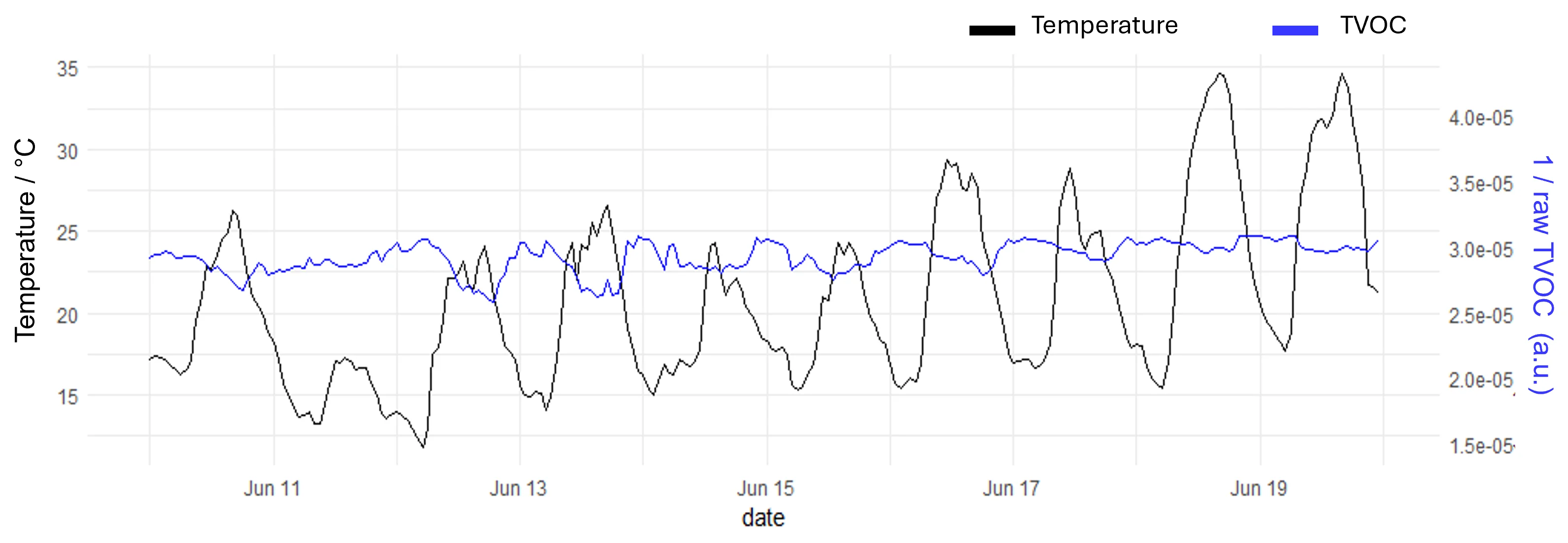
To assess the potential impact of temperature, we compared the sensor’s raw TVOC signal to the temperature it was exposed to. The results show no visible agreement between the two datasets, which is also confirmed by the scatterplot analysis.
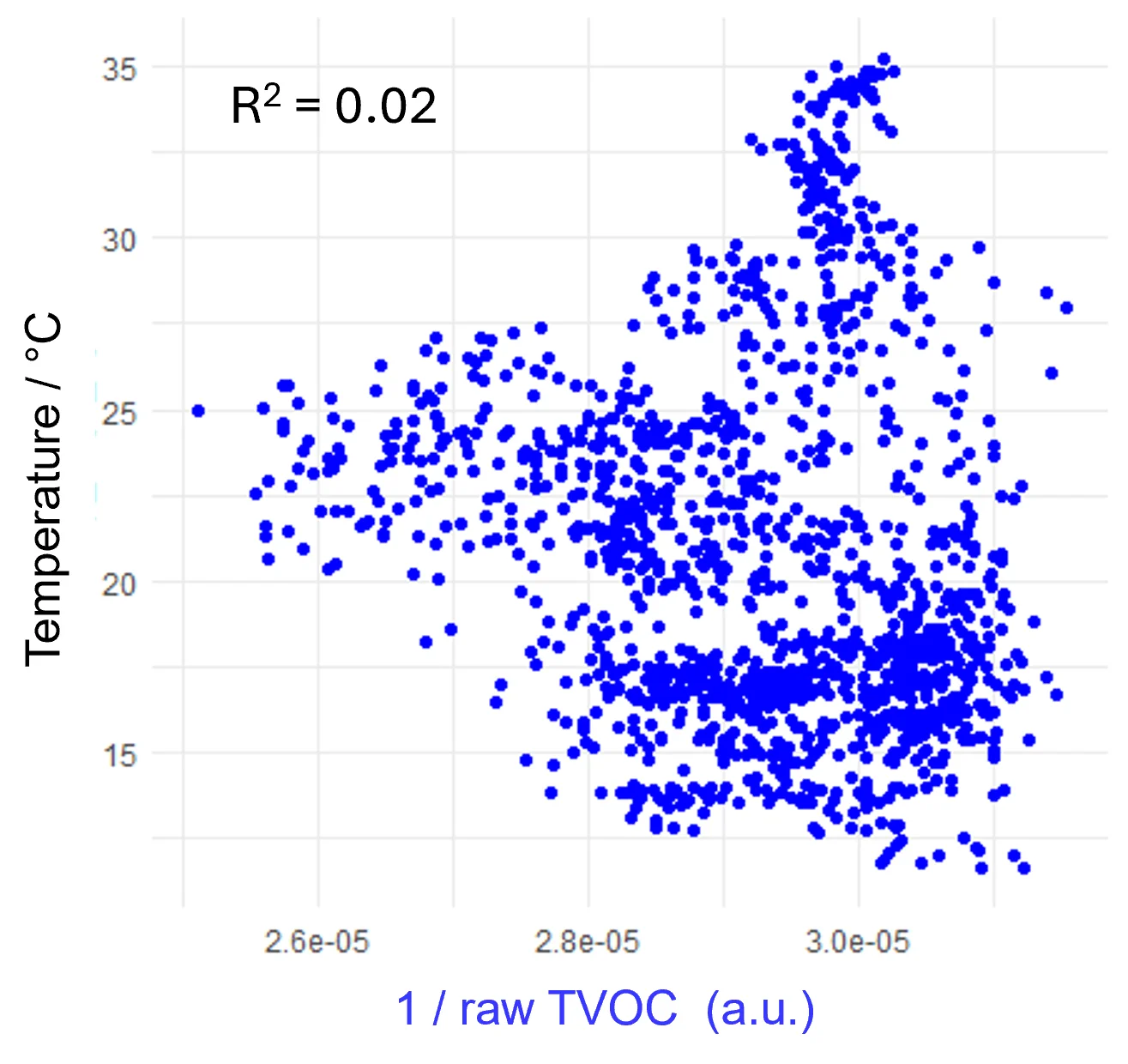
The scatterplot points are widely dispersed and do not form a clear linear pattern. This lack of correlation is quantified by an R-squared value of 0.02, which indicates essentially no relationship between the temperature and the TVOC signal. Again, for reference, an R-squared of 1 would represent perfect correlation, while an R-squared of 0 indicates no correlation.
Based on these findings, the TVOC sensor does not exhibit interference from temperature fluctuations within the tested range. However, this analysis is limited to a specific set of conditions. Further testing across different seasons and a broader range of temperatures would be necessary to confirm this behaviour under more extreme environmental conditions.
To investigate whether humidity influences the performance of a TVOC sensor, we compared the raw TVOC signal to the absolute humidity, measured as the amount of water (in grams) per cubic meter of air. This analysis aimed to determine if cross-sensitivity to humidity affects the sensor’s output.

The comparison yielded an R-squared value of 0.43, indicating a moderate agreement between absolute humidity and the raw TVOC signal. This level of correlation suggests some relationship between the two variables. However, upon consulting with VOC experts from Empa, it became evident that this observed correlation is likely due to a genuine interaction between humidity and TVOC concentrations, as both meteorological factors and VOC levels in the air can be influenced by the same factors (e.g. boundary layer height).
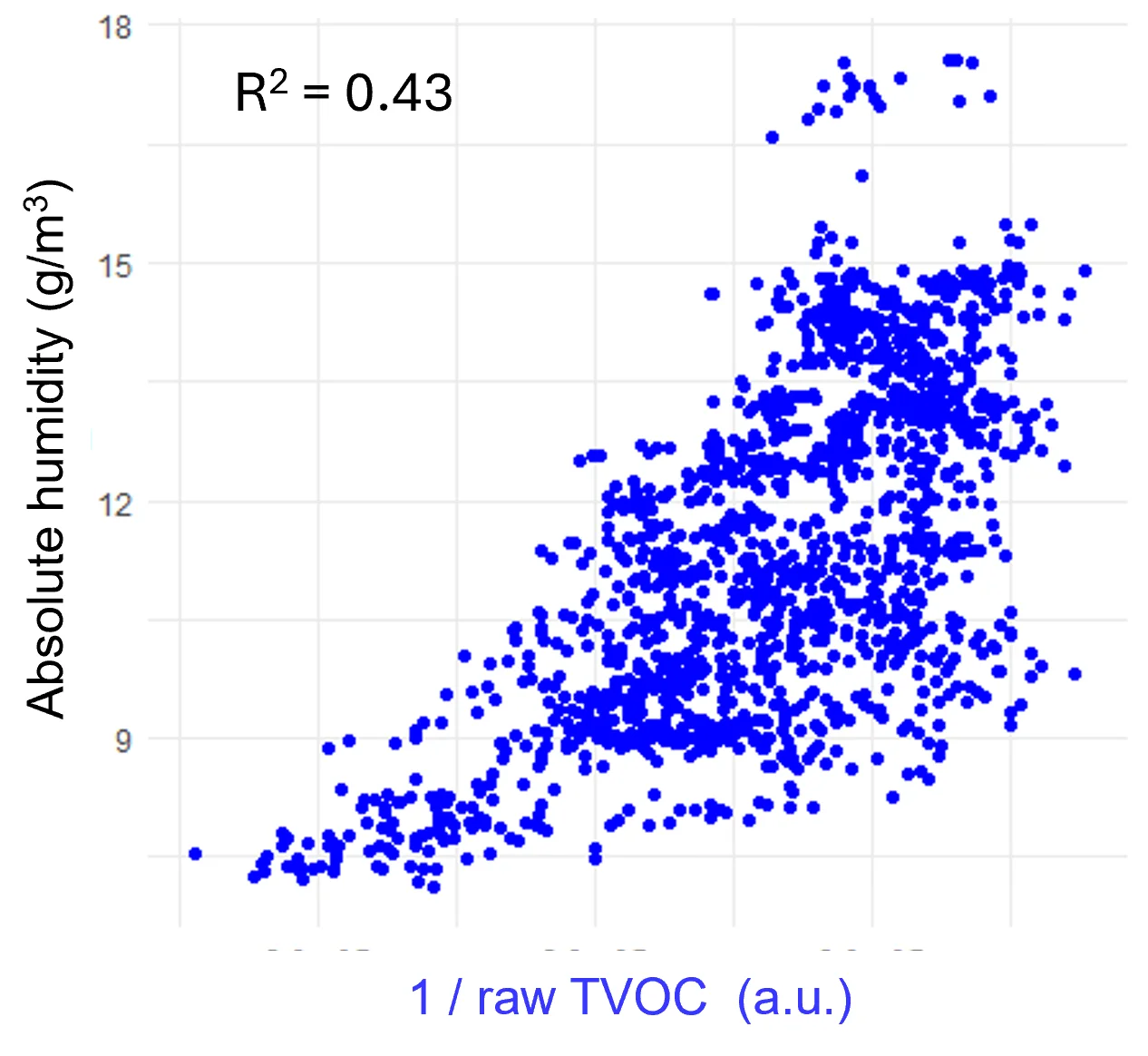
If the sensor is cross-sensitive to humidity, adding humidity as a factor into the calibration should improve the accuracy of the sensor. We tested this here:
| MODEL 1 | MODEL 2 | |
|---|---|---|
| Calibration formula | TVOC_cal = 1/TVOC_raw * scaling factor + intercept | TVOC_cal = 1/TVOC_raw * scaling factor + humidity * humidity_correction_factor + intercept |
| RMSE | 64 ppb | 64 ppb |
| R2 | 0.27 | 0.27 |
As you can see with the R-squared value, the calibration model doesn’t improve even if we include humidity.
While there is some correlation between humidity and the raw TVOC signal, this relationship is likely due to a real correlation between humidity and VOC concentrations rather than the sensor being directly cross-sensitive to humidity. Furthermore, incorporating humidity into the calibration formula does not enhance the sensor’s accuracy. Therefore, the impact of humidity on the sensor’s performance is not significant under the tested conditions.
At the beginning of this article, we asked whether TVOC sensors are actually useful and, specifically, how good the sensors inside the AirGradient monitors are. Is it possible to extract raw signals from the sensor and get a more useful absolute reading?
Based on our findings, the answer is no. The sensor is limited to tracking relative changes in VOC levels, meaning it can detect when VOC concentrations in the environment increase or decrease but cannot provide precise absolute values.
Sensirion, the sensor manufacturer, is aware of these limitations and has optimized the sensor’s output to align with its capabilities. As a result, the official output is presented as a relative index rather than absolute VOC concentrations. This design choice ensures that the sensor performs well within its intended scope of use.
It is also important to note that the default Sensirion index calibrates to 100 after 24 hours of use, which may limit its ability to reveal longer-term trends. However, this is not the case with the raw signal, which could provide insights into these trends if analyzed separately. Alternatively, adjusting the learning gain offset of the index could help address this limitation.
Despite its limitations, the sensor is valuable for certain qualitative applications:
However, for more detailed insights, such as determining the quantity, type, or toxicity of emitted VOCs, more advanced and precise instruments are required.
The sensor also cannot detect constantly high TVOC concentrations. For example, in environments like a paint factory with consistently elevated VOC levels from solvents, the sensor would fail to pick up these persistent levels.
To further explore the sensor’s performance and limitations, we plan to conduct additional measurements in Dübendorf and compare the sensor to the reference instrument in different conditions. This will include data collection across various seasons to investigate whether temperature or humidity impacts the sensor differently under extreme conditions.
Additionally, while sensor drift is not a major concern for applications focusing on short-term changes, more data over extended periods may provide insights into the sensor’s long-term stability.
For a more detailed explanation of TVOC sensors and their applications, see the AirGradient TVOC explainer.
We would like to cordially thank the Empa team in Duebendorf, not only for putting up our sensors and providing reference data but also for providing advice and discussing the data with us!
Curious about upcoming webinars, company updates, and the latest air quality trends? Sign up for our weekly newsletter and get the inside scoop delivered straight to your inbox.
Join our Newsletter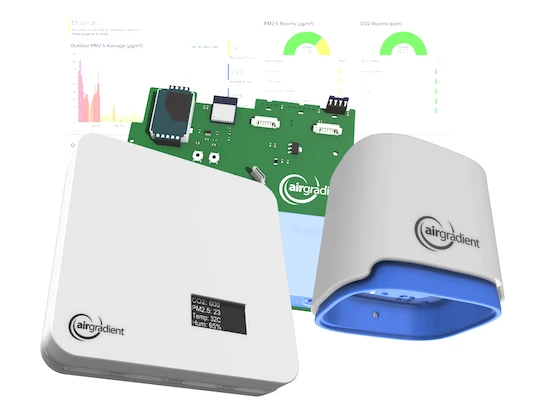
We design professional, accurate and long-lasting air quality monitors that are open-source and open-hardware so that you have full control on how you want to use the monitor.
Learn More